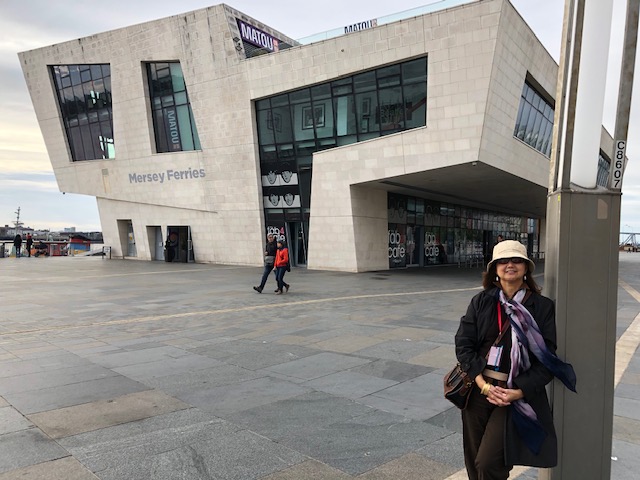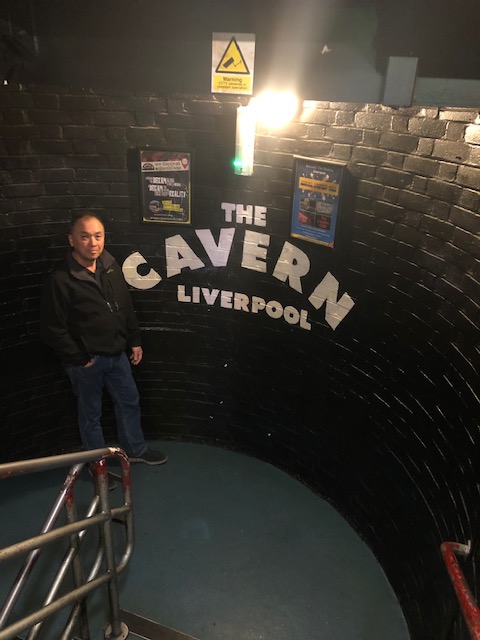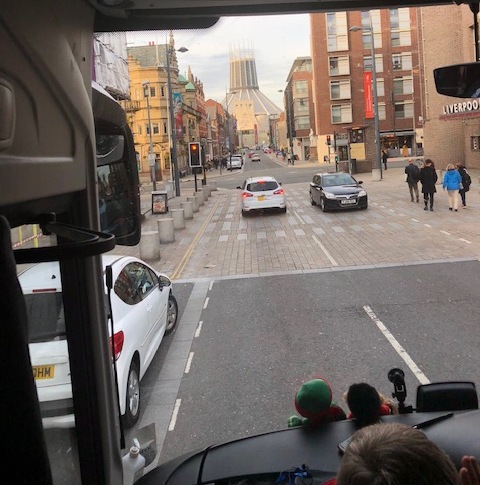‘Just 17’ again in the birthplace of the Beatles
/Can't miss the Cavern Club, where Beatlemania was born (Photo courtesy of Cherie Querol Moreno).
When I “was just 17,” so the early Beatles’ hit “I Saw Her Standing There” begins, the Fab Four were already history. The band had broken up, their popularity diminished by drug-related run-ins with the law, topped by John Lennon’s declaration that they were more famous than, cue sign of the Cross, the Son of God.
They had outgrown each other as I and my contemporaries their music and messages of juvenile romance that reverberated throughout our adolescence. Even if I was not a fan of the Marcoses, I resented the Beatles’ supposed snub of a presidential reception in their honor, which to me was a national affront. Did not know till much later that the promoter had not informed them he had committed to their attendance with a private performance at Malacañang Palace. (Allegedly.) I also gave away that precious 45 rpm recording of the band's holiday chit-chat my indulgent journalist mom somehow acquired for me to add to my collection of pop discs. I never knew anyone else who had it, and eventually regretted handing it down to the boy who loved me just a bit more than he did the Beatles.
Secretly, my friends and I in the ‘70s were getting our minds blown with new sounds delivering radical thoughts that launched us on far-out trips occurring only in our heads, an escape from real horrors such as the rise of military rule and dictatorship in the Philippines, the US war in Vietnam War.
And just like that, the authors of the soundtrack of our childhood faded from my psyche. Or so I thought.
My little sister, Michelle, actually got her nickname from Paul McCartney’s ode to his French crush. We sang along to “Let it Be” with Apo Hiking Society’s Danny Javier at Mass in our school chapel on Katipunan Avenue. I was seduced by and almost joined a socio-spiritual movement after listening to George Harrison’s solo album “All Things Must Pass.” And then I fell into a funk when a mentally disturbed man shot Lennon dead near his Manhattan home in a desperate attempt to grab actress Jodie Foster’s attention. Plus, there's this coincidence: the birthday of the man I married falls on the same day the band officially split up in 1970; he, to this day, will participate in karaoke only for a Beatles song.
Beatlemaniacs we were all along and had quite forgotten so until we set foot on the city of their birth in September.
The street inspired the song and sends tourists singing the famous refrain, "Penny Lane is in my ears and in my eyes..." (Photo courtesy of Cherie Querol Moreno)
Stonehenge, not Liverpool, was our intended destination on this recent trip to the United Kingdom. At this point in our long lives, my loving co-traveler of 42 years and I have been seeking to walk the steps of the ancients in appreciation of our place in this human journey, and so the 4,500-year-old wonder beckoned.
Our tour of the British Isles, however, included a swing through the city that birthed the renowned moptops, nowhere near antiquity but definitely part of a glorious past. We were not alone in thinking so, we soon found out.
“Can you take my picture,” a fellow tourist asked as we trotted toward the monument of the four that got generations chiming “Yeah, yeah yeah!” I knew from the moment we set eyes on each other while checking in at our Kensington district hotel in London that she was Filipina.
“Of course, I’m a Beatles fan,” confessed the solo traveler from Southern California who declined to be named for this story. Widowed and retired from her medical profession, she had roamed Great Britain before and picked this tour purposely to connect with the minstrels of her youth.
We were the Baby Boomers in our diverse pack of gallivants from Australia, New Zealand, Indonesia, Singapore, Canada and, of course, the Land of the Free. We were several birthday celebrants, mothers and daughters, a dad and son reuniting away from their homes on two different continents, pensioners and students, a couple married for 52 years, two women obviously in love but were not ready to come out. We all craved a shot up close with "the lads" in frozen strut on the pier overlooking the Mersey River.
Fans get up close with the Fab Four on Pier Head (Photo courtesy of Cherie Querol Moreno).
Gerry (Marsden) and the Pacemakers immortalized the waterway with "Ferry Cross the Mersey," but it is John, Paul, George and Ringo Starr who preen perpetually for the multitude of pilgrims who fell in love, split up, and fell in love again to their many songs that are now classics.
The Beatles and the Pacemakers shared a manager, Brian Epstein, in their quest for fame as proponents of the "Merseybeat," the genre of that moment. Much earlier, we were informed by the running commentary on our coach that Lennon recruited Quarry Bank School classmates to form an American rockabilly-influenced "skiffle" band he dubbed The Quarrymen. They changed their name and spelling many times and ultimately kept their sixth monicker in 1960 in tribute to Buddy Holly's The Crickets.
Pier Head, as the waterfront complex is called, is a UNESCO World Heritage site. The bronze Beatles sculpted by Andy Edwards was unveiled by Lennon’s sister Julia Baird on December 4, 2015, 50 years since the Beatles’ last public appearance in their home city. Adapted from snapshots of the subjects at the same site in 1963, the sculpture was donated to the city by the Cavern Club, the basement watering hole where the Beatles first rocked out.
Pier Head is a UNESCO Heritage site overlooking River Mersey (Photo courtesy of Cherie Querol Moreno).
Their first gig was at lunchtime on February 9, 1961. Their fee? Five pounds. Ringo was yet to get the nod as drummer in 1962 after the ouster of Pete Best for reasons still mysterious to this day. They played 291 more times at Cavern Club until August 3, 1963, and never again. Today, it declares itself “The Most Famous Club in the World,” courtesy of the band that changed not just the club’s genre (it opened in 1957 as a French jazz club) but also enriched the city. In 2016, Beatles-related sales pumped 82 million pounds into the Liverpool economy, according to The London Times.
Indeed, the entire Mathew (with a single T) Street where the club reigns is a parade of commercial establishments dedicated to The Beatles.
Can’t miss the mother club with neon signs blaring from all sides. It’s easy to amble deep down several flights into the destination dungeon, but trudging back up was a slog for us whose knees have seen stronger days.
The famous club is several flights of stairs underground (Photo courtesy of Cherie Querol Moreno).
The subterranean spot forced us to adjust our vision and nod our heads to a pulsing live act and find patrons letting their hair down, swinging and carousing along in beer-fueled abandon. I could imagine how Ringo got a shiner reportedly from fans displeased with the sacking of his predecessor. Suddenly, Mickey and I were 11 and 13 all over again, straining our vocal chords in unison with our new mates in the safety of darkness and anonymity.
The last time we crossed over the Atlantic, our American dollars were a pitifully half the value of the pound. Today we could afford to be bullish, snapping up mementoes like it was 1964, when I had tagged along with my teen cousins on an expedition to downtown Manila to watch "Hard Day's Night." Our 30 pounds were worth an eponymous T-shirt, a pint of pale ale and an hour of reclaimed youth.
And we had thought Liverpool was a sad little town. In fact, the fifth largest city in England has always been a major port, home of Cunard and White Star Lines, and home registry of the ill-fated Titanic. It claims to have the oldest black community in the UK and the oldest Chinese community in Western Europe. Now that's important trivia I probably would not have stumbled upon had we not gone on this adventure.
Like San Francisco's St. Mary's Cathedral, the architecture of Liverpool Cathedral looks like a nun's wimple (Photo courtesy of Cherie Querol Moreno).
Paul McCartney surprised neighbors of pet-friendly Liverpool Philharmonic with a mini-concert during a visit with TV host James Corden (Photo courtesy of Cherie Querol Moreno).
But the biggest discovery from our Liverpool holiday was Lilian Patricia "Lita" Roza, the first woman to top the music charts in the UK with her cover of the Patti Page blockbuster "(How Much is) That Doggie in the Window." In 1953! Why the significance? While discographers concur that she was born in Liverpool, they disagree on the ethnicity of her father. He was Filipino, says Wikipedia, which explains the singer's "sultry looks." However, AllMusic.com names her father as "Francis Vincent Roza, a Spanish marine engineer." The Guardian obituary described her father as a "Spanish-born marine engineer." What they all agreed on was that he played the accordion and the piano at night clubs, inspiring the most gifted of his seven children.
Roza was 12 when she auditioned and got a part to dance in a pantomime. She graduated to bands to become lead singer, peaking as the New Musical Express poll's "Top British Female Singer" from 1951 to 1955. Around that time a lot of shakin' was goin' on across the Pond that was eclipsing torch singers like Roza. 1955 was the year John Lennon became obsessed with rock 'n' roll while on a day trip to the seaside town of Blackpool with his mother Julia, according to a pivotal scene in the 2009 film "Nowhere Man."
Her paternal heritage unverified, Roza passed away at 82 in 2008. One of her most memorable appearances was the 2001 inaugural ceremonies for the Liverpool Wall of Fame where she was the first chart-topping artist to be honored with a bronze disc. The Wall faces the Cavern Club, whose most famous band sparked a musical revolution, and whose famous fan and fellow Liverpudlian was a legendary singer who might have been a Filipina.
Cherie M. Querol Moreno is a Commissioner with the San Mateo County Commission on Aging and executive director of nonprofit ALLICE Alliance for Community Empowerment. She is editor at large of Philippine News, columnist for Philippines Today USA and contributor to Rappler and GMA News Online.
More articles by Cherie Querol Moreno









